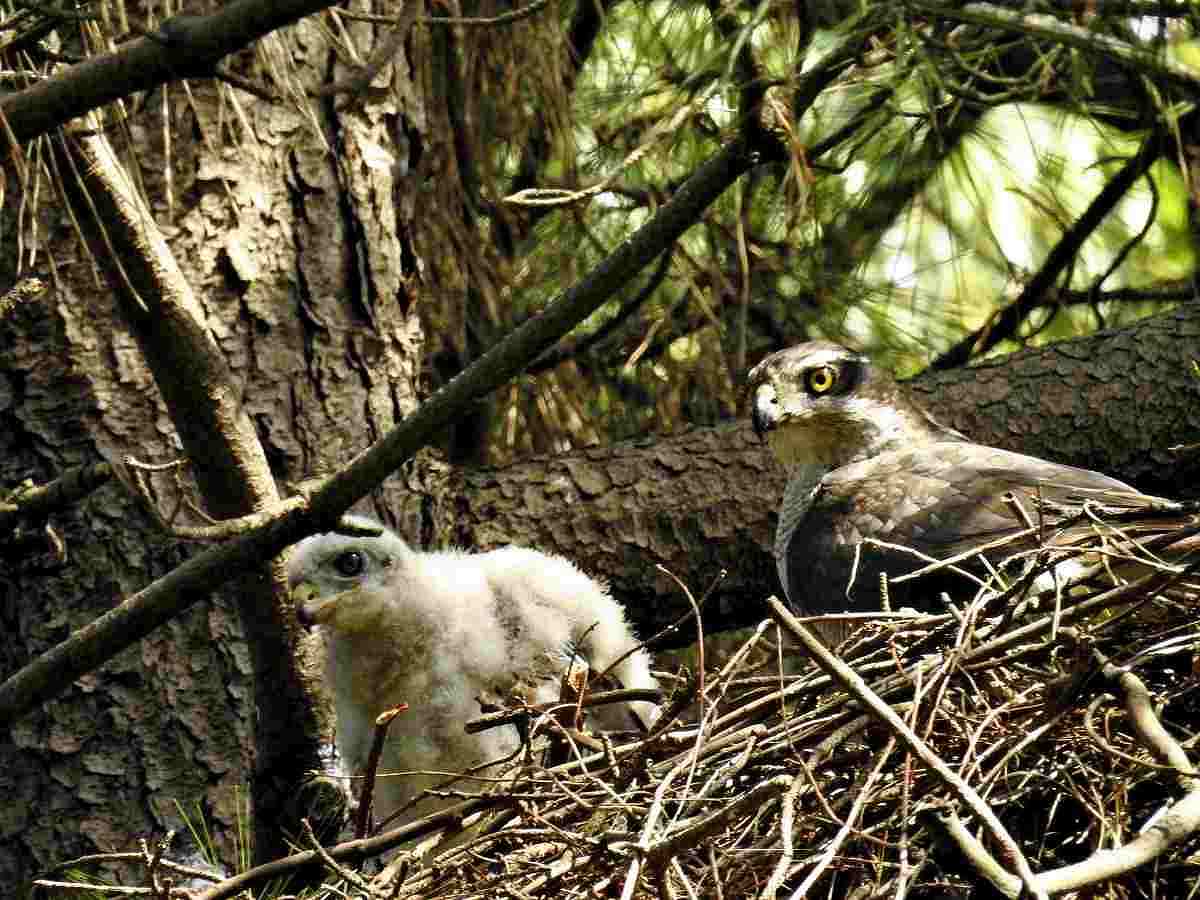
A female goshawk and her chick are seen at the Akasaka Estate in Moto-Akasaka, Tokyo, in June 2022.
6:01 JST, April 13, 2023
Forests of the Imperial Palace in Tokyo serve as home for many rare wild birds. Last year, a survey conducted by the National Museum of Nature and Science confirmed the presence of goshawk and owl chicks, among other species. It is rare for different kinds of birds of prey — who traditionally live in harsh habitats and have small populations — to breed in the same location.
Experts say the increasing diversification of bird species in central Tokyo is linked to crow-control measures and tree planting.
50 species
The Imperial Palace sits in the center of Tokyo and covers an area of about 115 hectares, around 25 times more than that taken up by Tokyo Dome.
The museum has conducted biological surveys at the palace three times since 1996 following a request from the then Emperor to keep an accurate record of the flora and fauna at the palace and monitor changes.
The surveys focused primarily on the Fukiage Imperial Gardens, where the Emperor and his family live and which occupy one-fifth of the palace grounds.
About 5,900 species of plants and animals have been logged in the forests, which includes 300-year-old Japanese oak and zelkova trees. New species have been discovered, too, including a large windflower (nirinso, in Japanese), which was later named Fukiage nirinso.
The bird survey team, which carries out annual counts, includes the Emperor’s younger sister, Sayako Kuroda, 53, who is a fellow of the Yamashina Institute for Ornithology and records species and population numbers in addition to searching for the nests and chicks of birds of prey.
Each year, the team logs about 4,000 birds of about 50 species. From around 2000, the group began to sight breeding goshawks and small birds such as long-tailed tits (enaga) — dubbed “forest fairies” — and, from around 2010, Japanese bush warblers.
Last summer, Kuroda and other specialists photographed goshawk chicks and recorded owl chick cries at the Imperial Palace and the Akasaka Estate in Moto-Akasaka, Tokyo.
Goshawks and owls need a sufficient availability of live food to survive. Many municipalities, including the Tokyo metropolitan government, have designated the species as endangered on their respective Red Lists.
“We’ve been able to prove that several carnivorous bird species breed at the Imperial Palace and the Akasaka Estate,” said Isao Nishiumi, head of the bird survey team and a senior researcher at the museum.
Corvid-thwarting measures
Nishiumi attributes the increase in raptor-species breeding to the falling number of crows in central Tokyo, explaining that the corvids often prey on chicks and eggs and destroy nests.
The Tokyo metropolitan government launched a crow-control program in 2001 that included the early morning collection of raw garbage to cut nuisance feeding, and the use of crow traps. As a result, crow numbers dropped at about 40 locations, including at parks and shrines, decreasing from 36,416 in fiscal 2001 to 13,058 in fiscal 2021 — an over 60% decrease.
Similarly, the number of crows at the Imperial Palace has fallen by more than half, and goshawk-chasing incidents have been observed less frequently than before. Conversely, scattered crow feathers are now seen more often, suggesting that goshawks are preying on crows, Nishiumi noted.
Forest bird uptick
An increasing number of forest-living birds such as long-tailed tits and Japanese bush warblers have been spotted in central Tokyo following the successful implementation of crow-control and tree-planting measures.
A wild-bird distribution survey conducted from 2016 to 2021 by the Japan Bird Research Association, a Tokyo-based NPO, logged a total of 374 long-tailed tits at 83 locations in the capital compared to 98 at 25 locations about 30 years ago. Japanese bush warblers, meanwhile, increased from 250 at 81 locations to 430 at 126 locations.
Narcissus flycatchers (kibitaki), which breed in mountains and forests, are also seen more frequently now.
In contrast, such wild birds as sparrows, swallows and larks are on the decline, a trend believed to be linked to a decrease in their farmland and grassland habitats. Larks are classified as “vulnerable” on the metropolitan government’s Red List.
“In addition to tree planting, we need to promote a wide range of greening activities, including the maintenance of grasslands,” said Mutsuyuki Ueta, 53, a representative of the NPO.
Hiroyoshi Higuchi, a professor emeritus at the University of Tokyo and a specialist in bird species, said: “The presence of a variety of wild birds across a number of species enriches urban living environments. We should also recognize that seeing and hearing wild birds instills a sense of calm in many people.”
"Society" POPULAR ARTICLE
-

M4.9 Earthquake Hits Tokyo, Neighboring Prefectures
-

M7.5 Earthquake Hits Northern Japan; Tsunami Waves Observed in Hokkaido, Aomori and Iwate Prefectures
-

Tsukiji Market Urges Tourists to Avoid Visiting in Year-End
-

Israeli Tourists Refused Accommodation at Hotel in Japan’s Nagano Pref., Prompting Protest by Israeli Embassy and Probe by Prefecture
-

M5.7 Earthquake Hits Japan’s Kumamoto Pref., Measuring Upper 5 Intensity, No Tsunami Expected
JN ACCESS RANKING
-

Keidanren Chairman Yoshinobu Tsutsui Visits Kashiwazaki-Kariwa Nuclear Power Plant; Inspects New Emergency Safety System
-

Imports of Rare Earths from China Facing Delays, May Be Caused by Deterioration of Japan-China Relations
-

University of Tokyo Professor Discusses Japanese Economic Security in Interview Ahead of Forum
-

Japan Pulls out of Vietnam Nuclear Project, Complicating Hanoi’s Power Plans
-

Govt Aims to Expand NISA Program Lineup, Abolish Age Restriction



◎あいさつされる愛子さま_20251214YGTGS000705_C-2-250x172.jpg)





















